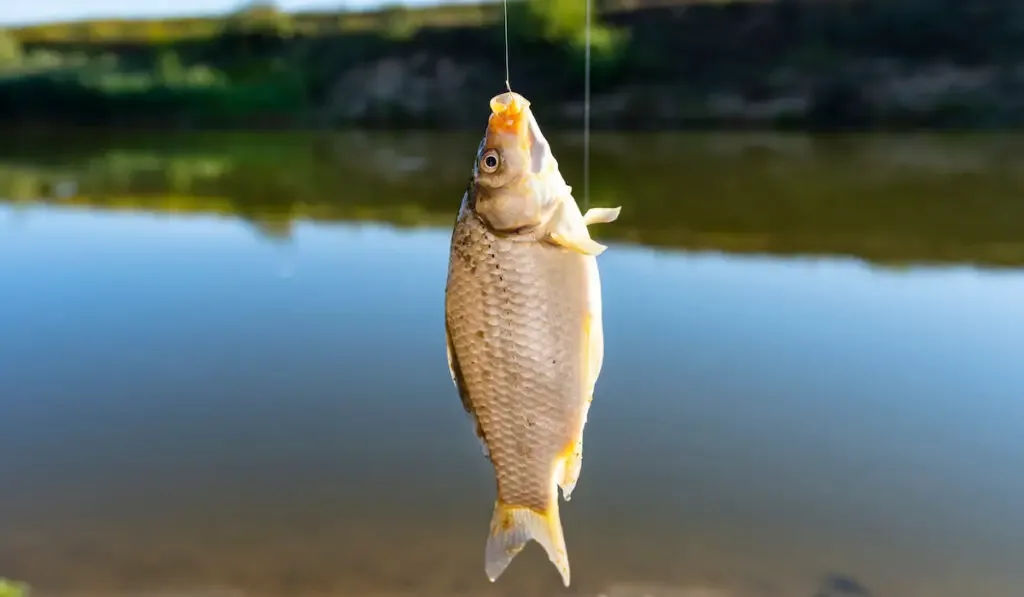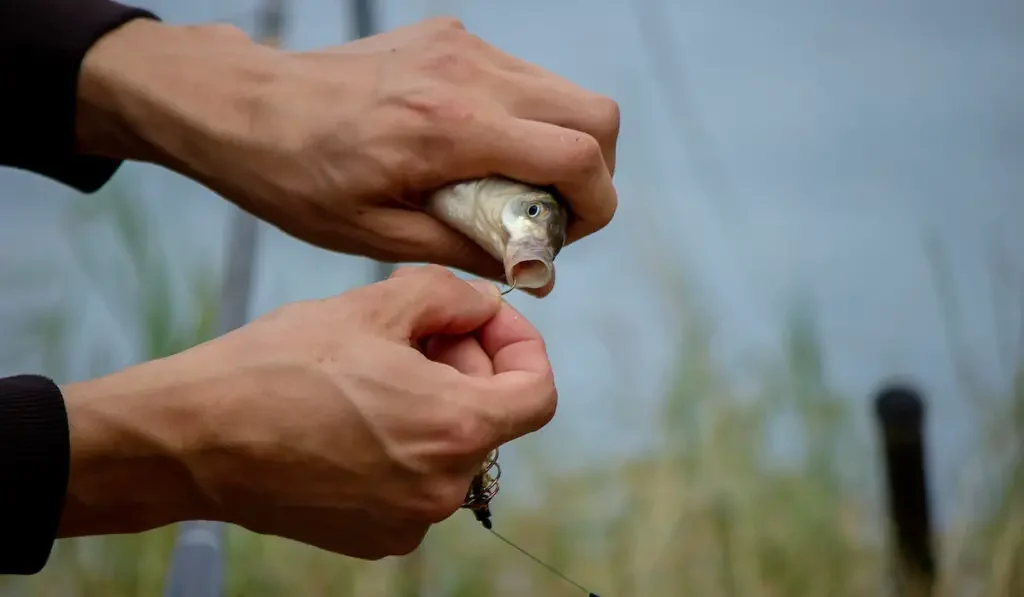Over the years, the use of hooks for fishing has been a common practice among anglers. Many anglers do not believe that fish feel any pain when they have a hook stuck in their mouth.
Some anglers do not also understand how the use of these hooks can be harmful to their survival.
Do hooks hurt fish?
Hooks can hurt fish. Just like humans and many other animals, fishes have nerves that enable them to feel pain. When fishes get caught on hooks, they not only feel physical pain but are also terrified. These hooks not only injure their mouth but several other parts of their body, including their eyes and gills.

As you read through the rest of this post, we take you through the pain fishes suffer from hooks. We also talk about the possibility of healing from the injuries, safer hook variants, and much more.
Table of Contents
Do Hooks Hurt Fish?
As we already mentioned, hooks hurt fishes since they have nerves that allow them to feel pain.
When a fish gets hooked, the tissues around its mouth are severely damaged. The wounds will then trigger the release of chemicals that elicit the sensation of pain in the nerves.
Sometimes the fishes may end up swallowing the hooks, and some anglers may try to retrieve them.
Anglers will often force a pair of pliers or their fingers down the throat of the fish. In a bid to get their hooks back, the angler may also rip out part of the fish’s guts and throat.
After being released from their hooks, some fishes tend to be distressed. Some may even die.
Do Fish Feel Pain From Hooks?
Yes, fishes feel pain from hooks.
Fishes may not scream when they get caught on hooks or when they have the hooks ripped off their mouths. But their reactions may show some evidence of suffering.
Some neurobiologists are of the notion that fishes possess a nervous system that understands and react to pain.
Fishes of the higher vertebrate category have neurotransmitters like endorphins that aid in relieving suffering. The only reason the nervous system of a fish will produce endorphins is to quell the pain.
Some researchers have made an elaborate map showing over 20 pain receptors (nociceptors) in a fish’s head. It also includes those points where the hook of an angler will pierce the fish’s flesh.

Do Fish Hook Injuries Heal When Doing Catch and Release Fishing?
Any responsible and experienced angler knows that retrieving a hook from the mouth of a fish should be done with extreme care.
Yet when trying to remove the hook, the angler may do more damage than desired. This raises the question among beginner anglers, do fish hook injuries heal?
The damage caused by a hook to any bony fish can heal over time. Almost all bony fishes can regenerate many of their body parts.
Their ability to regenerate includes growing new fins, plucked scales, and amputated gill filaments. The original colored spots or strips on a new fin can also be restored.
Fishes under the cartilaginous fish category not as lucky. Like humans, the injured spot on a cartilaginous fish will heal to form scar tissue. Unlike bony fishes, when a cartilaginous fish loses a fin, it cannot grow a new one.
With bony fishes being able to regenerate new gills, it is no surprise that they can heal hook injuries. Healing is even more likely when anglers use the appropriate hook removal techniques when retrieving their hooks.
Can a Hook Kill a Fish?
Yes, a hook can kill a fish. After a fish is caught and released, there are several reasons why it may die.
The physiological stress due to the struggle during its capture and injuries sustained from the angler or hook are common causes of death.
Some fishes may end up dying even though they look unharmed. When fishes get caught on hooks, they tend to struggle for an extended period. This struggle can cause exhaustion and stress.
The exhaustion is a result of the accumulation of lactic acid in their blood and muscles. With this comes severe fatigue, which can lead to death, physiological imbalance, and muscle failure.
Wounds sustained from hooks might seem minor to anglers but can severely damage internal organs, gills, or eyes.
When a hook is deep in the fish’s gut or throat, cutting the leader off is ideal. Once the leader is removed, you can leave the rest of the hook in the fish.
Any prolonged attempt to retrieve the hook may cause more harm to the fish.
When healing, fishes can encapsulate, reject, or expel hooks. Encapsulation involves covering the hook with cellular tissue or calcified material during the healing process.
Hooks are made with various materials, and some of them can be toxic to the fishes. The toxicity of such hooks can lead to the death of the affected fish.
Since bronze and steel hooks are rejected or dissolve faster, they are less toxic than nickel-plated, stainless steel, or cadmium-plated hooks.

Best Hooks for Catch and Release Fishing
Catch and release hooks are hooks specifically crafted to increase the survival rate of fishes that are released.
Here is a list of hooks that are ideal for catch and release fishing:
J-Hooks
J-hooks are the most versatile and traditional hooks available. When the j-hook is set up correctly, it helps to minimize the mouth damage a fish sustains.
This, in turn, makes it ideal for catch and release fishing. It is one of the many reasons why catch-and-release anglers use the J-hook.
Circle Hooks
Circle hooks are crafted to ensure the point turns away from the shank, forming a circular shape.
Using circle hooks instead of J-hooks can reduce the probability of the fish getting gut-hooked significantly. You can also use circle hooks for freshwater and saltwater fishing.
After extensive research by biologists, these hooks have been deemed ideal for catch-and-release anglers.
Barbless Fishing Hooks
Barbless fishing hooks are easy to find online or in tackle shops. Unlike barbed hooks, these hooks are easier and faster to retrieve from fishes. It ensures the anglers can release the fishes into the water more quickly.
If you do not have any barbless hooks, you can use hemostats and pliers to crimp down on the barbed variants you have.
Quick-Release Hooks
A quick-release hook has a short shank, a unique release sleeve, and is also equipped with an extra tagline.
When a fish gets hooked, you can release the sleeve quickly by pulling the tagline. This, in turn, releases the fish from the hook.
Hook retrieval using a quick-release hook can be done without even touching the fish.
Final Thoughts
Fishes get hurt and feel pain when they get caught on hooks. Although some fishes can heal their injuries, some may still die.
Especially if they are not released correctly. Fortunately, there are several hooks that anglers can use to ensure fishes survive after they are released.
Resources
- https://www.fix.com/blog/catch-and-release-fishing/
- https://www.takemefishing.org/how-to-fish/fishing-gear-and-tackle/catch-and-release-hooks/
- https://myfwc.com/research/saltwater/fish/snook/reduce-catch-release-mortality/
- https://www.begintofish.com/does-a-fishs-mouth-heal-after-being-hooked/
- https://www.peta.org/living/entertainment/the-cruelty-of-catch-and-release-fishing/
- https://www.peta.org/issues/animals-used-for-food/factory-farming/fish/fish-feel-pain/
- https://www.kamloopsthisweek.com/community/the-outdoor-narrative-do-fish-really-feel-pain-as-do-we-humans-1.24137098

